Chris Baty's Blog, page 35
August 6, 2021
4 Easy Steps for Outlining a Novel as a Pantser

Every year, we’re lucky to have great sponsors for our nonprofit events. Plottr, a 2021 NaNo sponsor, is a visual outlining software that helps you plan your book for success. Today, author Troy Lambert shares some tips for outlining a novel when you’re used to flying by the seat of your pants:
Pantsing a novel can be great—after all, writing into the dark and discovering the story as you go is kinda fun, right?
But you probably also know it can lead to nonsensical plots, writer’s block, and endless rewrites.
Well, don’t worry. As a book coach, editor, and mystery author of over 25 novels, I’ve been there myself… and I understand exactly what you’re experiencing.
The good news is you can use this simple four step formula to give yourself the best of both worlds: a general roadmap for your novel that still lets you take fun detours along the way.
Step 1: Write Down Your Big IdeaThe Big Idea (with capital letters) of your story is what most pantsers start with.
You have a character, a world, and a general sense of what your book or story will be about, and then you sit down, write, and discover what happens.
For example, the Big Idea of Hunger Games might be described as follows:
A dictator controls his subjects by pitting districts against one another in an annual tournament where there can be only one survivor.
So, Step 1 of my outlining process for pantsers is simple: jot down your Big Idea on paper or in an outlining tool like Plottr.
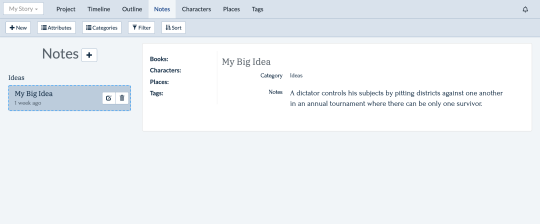 Step 2: Write a Summary of Your Big Idea
Step 2: Write a Summary of Your Big IdeaThis is where you let your pantser flag wave proudly for all to see.
(I say “think will happen” because we all know your story can take new turns as you write it.)
All you are doing here is fleshing out your idea into a short narrative – as short as one page to as long as three or four pages.
These ideas do not have to be in the exact order they will happen in the book.
Just try to answer this question: what does the reader need to know for your story to work?
Using the Hunger Games by Suzanne Collins as an example, we can even put the summary of the Big Idea into bullet points:
In a ceremony, those who will be in the games are chosen by lottery (idea: maybe we could call them tributes?)The other tribute from her district is a friend of Katniss who happens to have a crush on her. (Peeta)The participants from each district are transported to the capital.They are instructed by former victors on tactics they can use to win (idea: maybe Katniss and Peeta’s victor is not very helpful, at least at first)The participants are given time to train, and to impress potential “sponsors” who will help them in the games.Katniss gains popularity and the interest of some people, but not on purpose. The games begin.Etc.You can see from this very short example that we haven’t even gotten to the scene level yet.
This is just a series of things that could happen, sprinkled with potential ideas we might use along the way. There is nothing here that will impact your muse and your ability to be creative and spontaneous when you actually start writing the book later.
To recap, then, Step 2 of my Pantster Outline Formula is to sit down with your Big Idea and write a summary of the events you think will happen in the book to support it.
 Step 3: Divide Your Big Idea Into Parts
Step 3: Divide Your Big Idea Into PartsOnce you have created your summary, it’s time to divide it into parts.
How many parts? It doesn’t really matter. You can divide it into three acts, four acts, or three sections simply labelled beginning, middle, and end.
If you’re a pantser, the key is not to divide the summary of your Big Idea into too many parts. Then it can start to feel like a real outline, which can cause writer’s block, stifle your creativity, and make you want to chuck your computer at the wall.
Taking our Hunger Games bullet points above, we can start to organize them like this:
Part 1:
In a ceremony, those who will be in the games are chosen by lottery (idea: maybe we could call them tributes?)The other tribute from her district is a friend of Katniss who happens to have a crush on her. (Peeta)The participants from each district are transported to the capital.Part 2:
They are instructed by former victors on tactics they can use to win (idea: maybe Katniss and Peeta’s victor is not very helpful, at least at first)The participants are given time to train, and to impress potential “sponsors” who will help them in the games.Katniss gains popularity and the interest of some people, but not on purpose. The games begin.You could think about if the story works better as a three act or four act structure, but don’t get in your own way.
In other words, Step 3 of this process is to divide your Big Idea Into parts until you generally feel comfortable—and then stop.
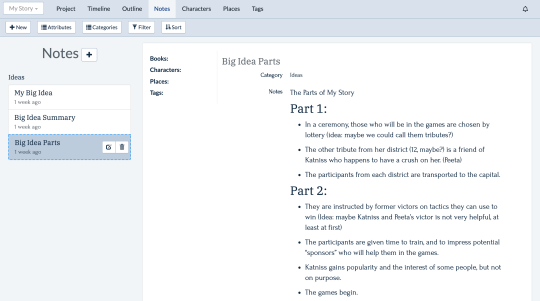 Step 4: Map Your Small Ideas for Each Part
Step 4: Map Your Small Ideas for Each PartThis is where things get a little different for each pantser.
At this point, you may notice certain things are out of order or that you’re missing some pieces you need to make the story work.
It’s time to start building out the parts of the story you’ve outlined with your small ideas.
Small ideas are the moments and events that happen in each part of your story that give it life – a scene or a chapter, for example.
So, how can you map your small ideas to its parts?
Well, that answer is as individual as your writing style and your story. But let’s think about this.
Our first bullet point was this: “In a ceremony, those who will be in the games are chosen by lottery (idea: maybe we could call them tributes?).”
The small idea to flesh this out could be:
Katniss goes to the lottery ceremony with her sister Prim, who is attending for the first time. Prim is chosen, and Katniss takes her place because she knows her young sister won’t survive the games. The second tribute from her district is chosen, and she is devastated that to win herself, she may have to kill someone she cares about.
You could break this out into bullet points or whatever format you prefer.
The point is this – we have now introduced Katniss’ sister, some additional tension and conflict to the lottery (already a bit stressful), and we have a little more detail via our small ideas that can keep you going for a chapter or two.
Do this for each bullet point, adding as many small ideas as you need to make it easy (and fast) to write each section, but not so many that it overwhelms you.
To make this process even easier, you can use a software program like Plottr (the one I swear by), a book outlining tool that lets you visualize your ideas.
Step 4, then, is to map your small ideas for each part.
And voila! Once you’ve done that, you have your first outline.
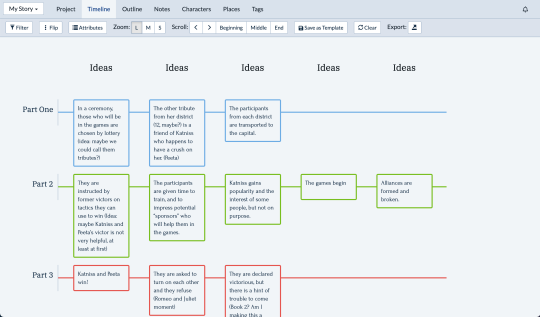 Start Writing!
Start Writing!Now that you have a basic outline, it’s time to get pantsing… I mean writing.
(To help, you can download the sample Plottr file from this article here.)
But when and how do you use your handy dandy roadmap?
If you feel stuck or a bout of writer’s block coming on—or even if you’re just not sure where you are in your story and what you need to write today—pull out your outline and find the clues you have left for yourself.
You won’t know exactly how things are going to happen or what your characters will do next (that’s the point!), but at least you’ll have an idea of where you are headed.
And that can make the difference between starting your novel and finishing.

Troy Lambert is a mystery author, editor, and publisher who has written over 25 novels. An associate member of the International Thriller Writers Association, he has spoken at LTUE, Westercon, the Plotting Summit, and often presents for the Idaho Writers Guild. He’s currently the Education Lead for Plottr, a visual outlining tool for writers. Troy lives in Boise, Idaho with his wife and a pack of very talented dogs. You can learn more at troylambertwrites.com.
Top photo by Kelly Sikkema on Unsplash.
August 4, 2021
Change the World With Your Writing

If you’ve ever looked at what’s going on in the world and thought, “This should change, but I don’t know what I can do about it,” Young Writers Program participant Natalie G. is here today to encourage you to use your talents and change the world with your writing:
Words. Words are all around us. I just used words. 10, to be exact. Words make up life as we know it. What we say, what we write, what we read… it’s all words! Words are important. They are one way that we express ourselves. We use words to speak, to express opinion, to express thoughts, to express feelings. Words matter.
Let’s go back to the part about opinions. We all have opinions. Now, you’re probably thinking: “Yeah, I have opinions… so what? Everyone does!” Most people have opinions over things like certain foods, sports, colors, animals. Other people have bigger opinions, too. They have opinions about the world, about modern-day problems, and bigger issues.
But then there are people who don’t have any opinions at all. There are people who go through life without worrying about the world around them. They don’t worry about the issues of today. They choose not to see those problems. They may have “reasons” for ignoring the problems of this world. Some of those reasons might be as follows:
“Why worry? Those problems aren’t affecting me, anyways!”
Or…
“Why should I worry… I can’t do anything about those problems, anyways.”
That first excuse is for the people who don’t care about the people and the world around them. But I want to focus on the second excuse. That excuse is used by a vast majority of people. There are so many people out there that believe they have no control over the issues in their world, and they believe that they can do nothing about them.
You may be one of those people. That’s okay… keep reading; I’ll give you a reason to give up that excuse.
Let me start with this: you can do something. We all can.
The fact of the matter is that most of those problems our world faces today were created by humans in the first place, so guess who can fix them? Humans can. We can. There is no problem in this world which can’t be fixed. You might be wondering now, “Okay… nice thought… but what does this have to do with words? You took kind of a drastic turn here.”
Well, believe it or not, words are one of the solutions to those problems which our world faces today. Yes, words. You can use your words to fix those problems. You are most likely reading this because you’re a NaNoer who likes to write. Writing involves words, doesn’t it? So change the world with your writing.
Instead of being that person who believes that they can’t change the world, be the person that changes the world with their writing. We each have a voice which we can express beautifully in our writing. Here are some ways which you can change the world with your writing:
Write essays! Essays are a very powerful form of writing which usually revolves around a main topic.Speeches. Speeches are forms of inspirational, uplifting writing. Combine your writing with your active voice, and you have a very powerful tool. Poetry. Poetry can be very powerful and inspirational. It can be a great way to make your point in a meaningful way!There are so many other ways that you can change the world with your writing! It really depends on your personal writing preferences to find the form of informational writing which best suits you!
These are all ways in which you can change the world with your writing. And don’t be afraid to share your voice. Many people who could have changed the world were stopped in their tracks by others who doubted them. Don’t let others who doubt your ability to make a difference stop you. Because if no one else believes you can, I do. We can all change the world with our writing. One. Word. At. A. Time.

Natalie is a dedicated writer who is known for making her novels too long and then not revising them. Besides writing, she loves to read and play softball. She goes by many titles, some of which might be bookworm, creative nerd, and Anglophile (lover of all things British). She has an absurd affinity for old TV shows, Anne of Green Gables, and Pirates of the Caribbean. You can usually find her curled up in front of the TV watching Jack Sparrow be a doofus or James Bond defuse a bomb.
Top photo by Greg Rosenke on Unsplash.
August 2, 2021
Creating Introvert Friendly Writing Events

We’re all here to write and have fun, even if we take out approaches differently. NaNo guest Amber Roberts offers multiple methods to make spaces more welcoming for introverts.
Introverts are everywhere, but we seem to take up a hefty chunk of the writing community. While we enjoy our solitude, we’re not antisocial—we often appreciate the opportunity to gather with fellow writers! But, there are ways to help introverts feel more comfortable, participate more fully, and get more out of writing workshops, write-ins, and other gatherings.
Whether you’re hosting a low-key write-in at your local library, a writers’ social hour at a café, or a weekend-long writing retreat, these tips can help you create introvert-friendly spaces and plan more welcoming writing events for anyone, introvert or not.
Support Planning AheadCommunication is a big plus for many introverts. Help people who like to plan ahead when you send the workshop schedule via email before the event, share check-in instructions and a venue map on social media, or encourage attendees to email with any questions ahead of time. Keep the momentum going at the meeting location—make the check-in area easy to access and post signage directing attendees to the right areas.
Good communication benefits more than just introverts: People feel more comfortable when you let them know what to expect—which can mean a more engaged group that’s ready to participate.
Don’t Require Public SpeakingI don’t know about you, but the introductions portion of any gathering gets me flustered. I spend the entire time thinking about what I’ll say when it’s my turn to speak, and I still mess it up.
If you don’t want to let go of the intros, make it introvert-friendly: Instead of going around the room, provide a place for attendees to jot down their favorite writing advice, number one comfort read, or how many pets they have. Then, instead of one-by-one introductions, read the answers aloud to the group—it may even spark discussions.
Introverts may need time to process and consider the questions they want to ask during a Q&A portion of a workshop or author event. Avoid the lag in questions—when introverts may still be thinking about what they want to ask—by taking questions via a hashtag on Twitter or through email. Then, if there’s a pause in audience questions, you can refer to the responses coming to the inbox.
If you’re hosting a virtual event, make cameras and microphones optional, and encourage questions or comments via the chat window.
Encourage DoodlingEnergy—especially nervous energy—has to go somewhere. When someone is fidgeting, doodling, or even checking their phone, it doesn’t mean they’re not actively engaged, so don’t take offense. Sometimes the act of note-taking or scribbling a few little kitty faces in the margins helps introverts focus—and that’s science! Fidgeting can help generate ideas, too, so leave pipe cleaners, Legos, or smooth “worry stones” on tables for playing while plotting.
Designate Quiet SpacesWhile the stereotypical introvert is depicted as avoiding social contact at all costs, that’s not always accurate. Introverts might love hanging out with groups of friends or going to events, but they often need to recharge their social battery afterward. So, mix in some time to unwind and create quiet zones for use between activities. Encourage self-care during and after your writing event. If pairing writers for critiques, form groups based on preferred feedback style so nobody is overwhelmed by notes outside of their comfort zone.
Introvert does not equal isolated, but a few considerations can help us get more out of any event. Introvert, extrovert, or ambivert, try these tips and tricks to create welcoming spaces at write-ins, workshops, and other gatherings.

Amber Roberts (she/her) is a romance writer from New England, USA. After trying a handful of career paths including vet tech, events coordinator, and web developer, she decided writing was the perfect job. Now, she splits her time between a full-time copywriting job and writing novels when the sun goes down. Follow Amber on Twitter @ARobertsWrites or read short stories on her writing blog.
July 30, 2021
After Camp NaNoWriMo: How to Create Your Self-Editing Roadmap

Every year, we’re lucky to have great sponsors for our nonprofit events. ProWritingAid, a 2021 NaNo sponsor, helps you turn your rough first draft into a clean, clear, publish-ready manuscript. Today, Hayley Milliman, Head of Education at ProWritinAid, shares some tips on how to successfully edit your own manuscript:
So you’ve finished Camp NaNoWriMo. Congratulations! Finishing a challenge like Camp NaNoWriMo is no small feat and you should be proud of yourself.
After the excitement of finishing the challenge wears off, you might be wondering, “What comes next?”
If you have a complete (or nearly complete) manuscript on your hands, the next step in your writing journey is editing. But unlike the writing process which has clear start and end points, the editing stage feels murky and confusing for many writers.
Where should you begin? How will you know when you’re finished? Do you need to hire a professional editor or can you edit effectively by yourself? If you need to hire an editor, where do you find a good one?
In this post, we’ll break down the key editing stages all writers should focus on, as well as help you create a roadmap for completing these edits yourself.
The Key Stages of EditingWriting a book is like finishing a race: there’s a clear start and end.
Editing is less straightforward. While there might be a clear moment when you start editing, there often isn’t a specific time when you know you’re done.
So instead of thinking about editing as going from Point A to Point B, it can be helpful to think of editing as following several connected circular paths. You might take multiple laps around each path or you might decide to go through each path in order. It’s up to you!
The “paths” in editing break down into the following stages:
Content editing: Also known as developmental editing, this stage happens after you have a completed manuscript. During content editing, you’ll look at your manuscript holistically to see overall trends related to plot, characterization, scene, and pacing.Copy editing: After you finish looking at the content of your manuscript, it’s time to look at the copy. During the copy editing stage, you take a microscope to your word choice and sentence structure to make sure you’re using your sentences as effectively as possible. Copy editing is sometimes known as line editing. Some people refer to line editing and copy editing as separate stages, but for the sake of simplicity, we’ve combined them into one path where you take a deep look at your use of language.Proofreading: The final editing stage isn’t really editing at all. Proofreading is when you examine your manuscript and try to ensure consistency for the next phases of your publishing process. You’ll look at formatting, grammar, and spelling to make sure everything appears polished and consistent.Before publishing, you should take your manuscript through one complete cycle of all three stages of editing. You may choose, however, to complete two content edits or four copy edits or three rounds of proofreading. You might decide to complete all three phases of edits by yourself or you might bring in a professional for one or more stages. As we mentioned, there’s a lot of flexibility in the editing process.
Why You Are The Best Editor for Your WritingOne of the most common editing misconceptions is that you need to hire a professional editor to improve your manuscript. That couldn’t be further from the truth!
In most cases, you are the best editor for your writing—at least for the first few rounds of edits. Working with an editor can be expensive and time-consuming. To get the most value for your money, you should edit your manuscript yourself at least once before engaging with a professional editor. That way, you don’t waste the editor’s talents on fixing simple problems like spelling mistakes, passive voice and repeated words. Save your editor for the high value suggestions!
How to Approach Editing Your Own ManuscriptIf you do choose to engage with a professional editor, it’s important to polish your manuscript before you send it off.
During your content edit, you should examine your plot, characters, settings, and scenes. You may ask yourself questions like:
Are my characters’ motivations clear?Do my scenes have a clear arc?Are my settings vivid and memorable?Does the plot of my novel progress at an engaging pace?Are there any places where I need to cut information or add more information to make the reader’s experience better?When it’s time to complete your copy edit, you need to closely examine your word choice and sentence structure. Many writers find it helpful to use an editing tool while they complete their copy editing.
Software like ProWritingAid makes it easy for you to copy edit your own work. ProWritingAid has more than 20 writing reports that highlight everything from overused words to misplaced commas to confusingly constructed sentences. These reports make editing simple and fun, not to mention more effective.
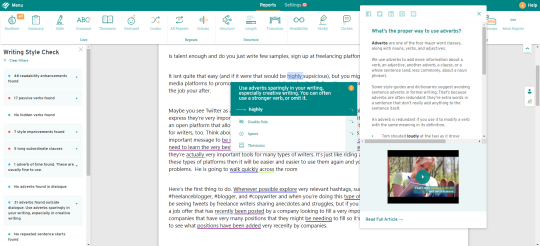
Many writers struggle with assessing their own writing. That’s where software can come in. You might not realize that you’ve repeated the word “sapphire” fifteen times on one page, but ProWritingAid can highlight such stylistic errors with the touch of a button.
Let’s take a look at how one of ProWritingAid’s most effective reports, the Sticky Sentences report, can help improve your writing.

Every sentence is made up of two types of words: working words and glue words. Working words are the words that carry meaning in the sentence—nouns, verbs, adjectives. If you changed them, the meaning of the sentence would change.
Glue words, on the other hand, are words that make the sentence stick together—conjunctions, articles, etc. Glue words are necessary, too, but if your sentence has too many of them it can become sticky. And sticky sentences create a negative experience for your readers.
Compare the following two sentences:
Sticky: I went over to my cousin’s house after school and then we just kicked the soccer ball around for a really long time.
Glue index: 61.9%
Rewrite: After school, I walked to my cousin’s house and we played soccer for hours.
Glue index: 33.3%
The second sentence is much clearer. By removing the glue words, the sentence becomes less confusing and more engaging.
Fixing stylistic errors like sticky sentences can drastically improve your writing. But these errors can be hard to find on your own, so using a tool like ProWritingAid to supplement your writing process can help your self-edit progress more effectively.
What’s Next?The editing stage might feel intimidating, but it’s full of possibilities. You’ve completed your manuscript—now it’s time to really make your book shine!
By approaching editing in clear stages, you can address all the necessary areas to make your work live up to its true potential. Start by examining the content of your manuscript, then zoom into your word choice and sentence structure (with the help of a trusty editing tool like ProWritingAid). Finally, polish your manuscript in the proofreading stage and it will be ready for whatever comes next: more edits, self-publishing, querying, or something else entirely.
The possibilities are endless!

As Head of Education at ProWritingAid, Hayley focuses on building engaging, helpful learning content for the millions of users who rely on ProWritingAid to make their writing clear and effective. Hayley has a robust writing portfolio and has written for dozens of publications on topics related to education, marketing strategy, history, entrepreneurship, and more. She has also published several books related to writing and history, one of which hit the Amazon bestseller list. When not working, Hayley loves hiking, skating of all kinds, and correcting people on Star Wars trivia.
July 28, 2021
“If you are having fun writing your book, write toward...
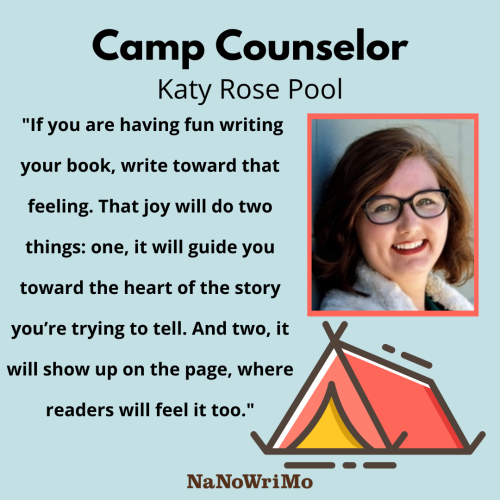
“If you are having fun writing your book, write toward that feeling. That joy will do two things: one, it will guide you toward the heart of the story you’re trying to tell. And two, it will show up on the page, where readers will feel it too.”
Katy Rose Pool, author of the Age of Darkness trilogy, was born and raised in Los Angeles, California. After graduating from UC Berkeley with a degree in history, Katy spent a few years building websites by day and dreaming up prophecies by night. Currently, she resides in the San Francisco Bay Area, where she can be found eating breakfast sandwiches, rooting for the Golden State Warriors, and reading books that set her on fire.
Your Camp Care Package is brought to you by Camp NaNoWriMo. Sign up to receive more Camp Care Packages at nanowrimo.org! Thank Katy Rose Pool for her Camp Care Package!
Image description: A graphic with a blue background and a red tent and NaNoWriMo logo. It includes a headshot of Camp Counselor Katy Rose Pool, and includes the quote text, “If you are having fun writing your book, write toward that feeling. That joy will do two things: one, it will guide you toward the heart of the story you’re trying to tell. And two, it will show up on the page, where readers will feel it too.“
July 27, 2021
Camp NaNoWriMo: What Comes Next?

Every year, we’re lucky to have great sponsors for our nonprofit events. Storyist, a 2021 NaNo sponsor, is a novel-writing environment for macOS and iOS that helps you track your plot, characters, and settings, and keeps all of your writing organized and accessible. Today, Storyist founder Steve Shepard is here to help you decide what to do with your Camp project after you complete it:
The end of Camp is always a little bittersweet. Over the last month, you’ve lived the high highs and the low lows with your characters in a world you’ve created. Now, whether you’ve “won” or not, the end is in sight, and it dawns on you that you’ll spend less time with those characters in that world. Well… darn. Camp was amazing. What’s next?
The second draft, of course!
But not right away.
Put your manuscript in the drawer for a month. Take some time to handle those chores you’ve artfully avoided during Camp and reconnect with the people around you. And be sure to reward yourself for making it this far.
Then, when you’re rested and ready, read your manuscript from start to finish in as few sittings as possible. The goal for this read is to experience your novel as a reader would. Don’t beat yourself up about the quality of the prose. You gave yourself permission to write quickly during Camp to make progress, remember?
With that high-level view of your novel fresh in your mind, make some brief notes. What stood out? What’s your sense of the story? Are there any major changes you’ll need to make? How is the pacing? Some people find it helpful to write the jacket blurb at this point (or rewrite it if you wrote one at the start of Camp).
Next, re-read the manuscript chapter by chapter. This is a deep read. Go slowly and check your facts along the way. Identify the inconsistencies and loose ends. Mark the purple prose for revision or elimination. Consider printing out a one-sided, double-spaced copy of your manuscript and putting it in a binder. This will give you a manuscript page on the left for markup and a blank page on the right for notes.
Armed with a fresh sense of your story and a stack of notes, you’re ready to start the second draft. As with the first draft, this will be a significant creative effort, but this time, you’ll ask your internal editor to join you instead of locking them in the closet.
As with the first draft, there aren’t any hard and fast rules on how to proceed, but here are some tips to help:
Make rewriting a daily habit. Because revision involves adding and deleting words, you’ll need a metric other than word count to measure your progress. “Chapters edited” is about the right level of granularity.Create a mockup of your book to put in your writing area for emotional fuel. This could be as simple as a hand-drawn dust jacket wrapped around another book. If you’re feeling ambitious, you could use a print-on-demand service like Amazon KDP or Blurb to print a sample paperback. Storyist has some tools to help you create the PDF. Share your revised chapters with others and ask for feedback. The folks in your cabin are good candidates. Or find a writers group in your area.Good luck! And remember, the rewrites (plural) will be hard work, but they will be worth it.
And congrats on your excellent work at Camp!
Steve Shepard is the developer of Storyist and an avid NaNoWriMo participant. A night and weekend writer for many years, he took some time off in 2002 to finish a novel. Not finding the writing tools he wanted, he decided to create them.
Top photo by Nick Fewings on Unsplash
July 26, 2021
Writing Doesn’t Need to Be Lonely

On this writing journey, sometimes we assume it’s a lonely road to success. However, blog guest Clarice Treml tells us her story of how finding community has shaped her writing journey.
I’ve been trying NaNoWriMo since I was 13, but now 20, I have failed consistently through all of these years. Many different projects, not a lot of words on paper, but every November, there I was, ready to try again because this event reminded me of my writer side and the projects I kept accumulating and never finished. Not even a draft.
Everything changed last November. In 2020, while social distancing, I discovered what was the essence of NaNoWriMo: community. After all this time, trying to go through this journey alone, I finally understood what was lacking, and it made all the difference. I reached 40k words and went back to writing, thanks to the group of writers I found. So, even staying home, here are ways to form connections and find a community.
Participate in SprintsConsist of challenging yourself to write as much as you can within a time limit. In a 10-minute sprint, for example, you focus only on writing for this period and then check your word count. If you can’t find someone to sprint with you, there are Twitter accounts that run sprints all day, so you feel there’s at least one person with you (that’s the only way I can bring myself to write some days). For those who thrive on healthy competition, you can see how many words others wrote for that same period and try to do more. No matter how many words you write, though, because people cheer on each other and celebrate all wins (being it reaching 50k or starting).
Chat and Join GroupsThere are many regions in the NaNo Forums, so you can find people near you, meet your MLs who are excited to help, and discover if there are Discord or Whatsapp groups to join. In my country, there is a group where we arrange sprints almost every day and an IRC chat where we run them. Between the sprint sessions, we usually talk about our process, how writing is going, and share about our struggles. This support motivates me when I’m about to quit. Also, you’ll always find someone sharing resources, blogs, videos, and podcasts, as well as discussions about writing topics like different points of view on the Hero’s Journey or if settings are more difficult to write than dialogue. You can ask for help to improve your draft in those groups and even find beta readers or make friends.
Make Writing FriendsTalking to other writers feels like finding people like you. NaNoWriMo is a collective marathon, so someone is going through the same thing you’re experiencing right now. That’s why it was so important to me to talk to writers who haven’t finished a single draft as well, and tried and failed for many years but kept on just like me. You discover people that write really fast and others that write a little every day, or some never won a NaNo, some are veteran winners. This diversity means you can find advice, tips, or just talk to people with different experiences. They can be similar to you or totally different!
Writing is a lonely activity while you’re writing, but you don’t need to go through your journey alone. Most of our favorite writers had writer friends, resulting in famous friendships like the one among J.R.R. Tolkien and C.S. Lewis.
Without the conversations I had with my writer friends, I think writing wouldn’t be as fun and transformative as it has always been for me.
Late nights on chat, talking about writing or random things (I even discovered new songs) with strangers that became sort of friends made NaNoWriMo even more meaningful to me and got me a rough draft, which I’m currently working on because now I have something. November is starting from nothing to getting something, be it memories, words, or friends.
There are thousands suffering and enjoying this long ride at the same time, and now, more than ever, they’re within our reach. Try reaching them, take part in write-ins (official or not), post in forums, anything you feel like doing. I promise you’ll get out changed.

Clarice Treml is a Brazilian writer who lives in São Paulo. She has been writing since she was able to read, having self-published a children’s book when she was 12. Currently, she writes YA and horror novels in Portuguese, and poetry in English. Besides writing, she loves reading poetry, obsessing over TV shows, and singing. You can follow her on twitter @ClariceTreml or check out her blog.
Top Photo by Devin Avery on Unsplash
July 22, 2021
Are Ya Having Fun, Wrimo?
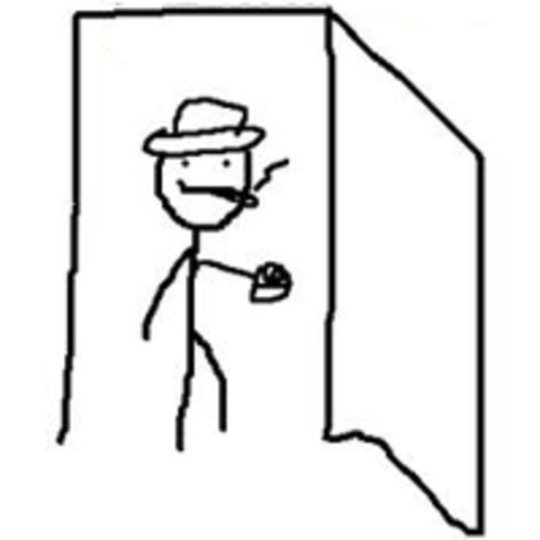
Every year, we’re lucky to have great sponsors for our nonprofit events. Campfire Technology, a 2021 NaNo sponsor, creates writing software to help storytellers write better stories faster. Get 30% off subscription-free writing software with Campfire’s coupon for NaNoWriMo writers! In this post, author Jackson Dickert shares the ultimate secret to writing good fiction:
Even if you’ve never seen the meme before, I think just about everyone can relate to it on some level. You’re sitting there playing a video game and your dad comes in and asks the iconic question, “Are ya winning, son?”
(Why is this a universal experience? Did we all have the same dad? Anyway…)
That’s kinda how I feel right now. I’m checking in on you guys, seeing how things are going. How’s the writing process? Are ya winning NaNoWriMo?
I was supposed to write an article with storytelling tips. Give you guys some writing advice to help you finish your manuscript. Oh, and I had some GENIUS insights too. I had the best writing tips and advice ever. Really good stuff that would have blown away even the most veteran and revered of writers. That “Lost Article”, as it will come to be known, would have made Shakespeare rise from the grave just so he could shake my hand. And then you know what I thought?
Instead, I’ll write about that funny dad meme.
Now, I know a lot about the craft of writing. But even more valuable to me, I know a lot about my needs and preferences. Could I crank out an article called “Top 100 Best Writing Tips” that’s chock-full of useful info? Sure, totally could. But if I write about a meme, that fits my writing process more. Cater your writing process to your needs and your art will be more unique, entertaining, and memorable than it would have been otherwise.
Let’s go back to your dad. Err, I mean our dad. When our dad pokes his head in the door and says, “Are ya winning, son?” he’s not actually worried about whether we’re going to win the video game. He’s not worried about if we’re going to win NaNoWriMo. The real question he’s asking is: are we having fun?
And that’s what I want to know. Are you having fun?
For all its faults, you probably enjoy writing. You’re a writer for crying out loud. You’ve researched this stuff, you’ve practiced your craft, you might even have a degree in this. But if you’re bogged down, if you’re not having fun, then consider for a moment: are you writing what you want?
There’s nothing better than getting a new idea for a story. You’re excited, the idea is amazing, it’s a guaranteed bestseller. But along the way, somewhere in that murky middle… all that can get lost in the mix. If you’re not winning, if you’re not having fun, look at the actual content you’re writing. If you lose that excitement along the way, like many of us inevitably do while we write our works in progress… this is your wake-up call.
Put something that gets you excited in your story. A scene to write toward, a character’s secret love interest, a dragon. Yeah, do that. Put a dragon in. Everything’s better with dragons.
(In my debut novel, I had a buck with tasers mounted to its antlers. No, seriously. Didn’t plan on it initially, but I had the idea for it somewhere in the middle. It motivated me to get through the writing rut I was in and gave me something fresh to work toward. That Taser Buck is one of my favorite parts of the book.)
Writing is supposed to be fun. That’s why we fell in love with it. So my writing process is to have as much fun with it as possible along the way. Doesn’t matter if it makes little sense. You’ll fix that in the next draft. Good fiction starts with you. If you’re miserable and not having fun while you write, it’s going to come through on the page. Quit taking this whole thing so seriously.
A mediocre idea written by someone who’s having fun is always going to be a better read than the great idea written by someone who hates what they’re creating.
Now go put a dragon in your story. I don’t care how you do it, figure it out.
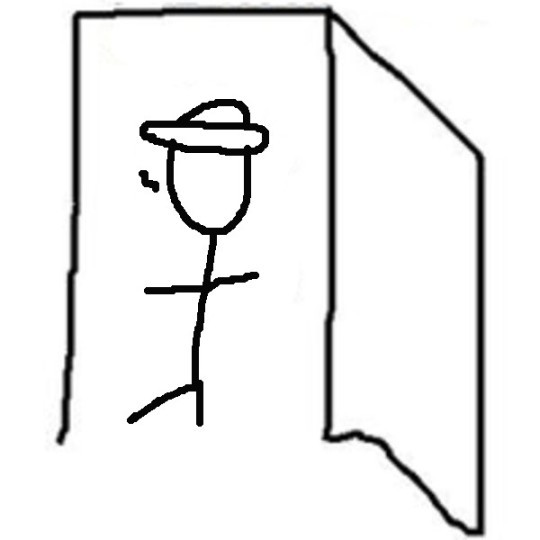
(That’s him leaving. Don’t make fun of me, I’m a writer, not an artist.)
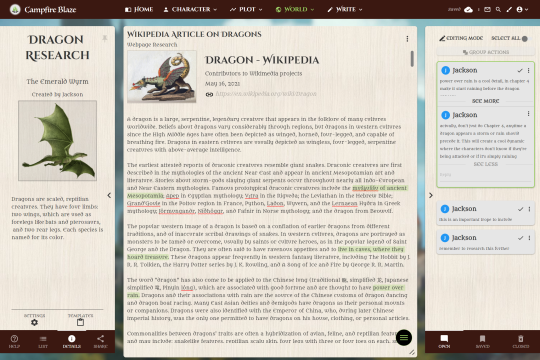
If having fun isn’t the issue and you’re struggling to stay organized while you write, though, try out Campfire. It’s a browser-based writing application with a full suite of organizational tools that help you write stories and worldbuild. With an offline desktop app and mobile app coming later this year, it’s the perfect tool to help you write better stories faster. It’s even free to use for small projects, so be sure to try it at www.campfireblaze.com.

Jackson Dickert is the Chief Marketing Officer at Campfire Technology, author of
The Quest for the Golden Plunger
, and is an avid manta ray enthusiast. (No explanation necessary, they are awesome.) He’s passionate about creating tools that help storytellers write better stories faster. Jackson loves to make people laugh, and his current hyper fixation is Vikings. Just all things Viking, really. He’s thinking about growing a beard. Maybe getting a tattoo. Potentially raiding England. We’ll see. Follow him on Twitter @SwagXMcNasty.
July 21, 2021
Find Your Writing Process

You need to have a writing process to get down and write your novel, so how do you start? NaNoWriMo guest writer Esther Wildman has some tips on helping you find your writing process.
“Write every day. Write your draft in three months or less. You need an outline to write a novel. Don’t outline, just write.”
Somewhere along your journey as a writer, you’ve probably heard or seen lots of pieces of advice like these and more. Before I started to write my first novel, I felt overwhelmed by all of the writing advice I was seeing, much of it conflicting with each other. I thought I wouldn’t be able to tell my story if I didn’t follow a specific formula. But the truth is, there is no one right way to write a novel. There are so many ways one can write because writing is so individual. Whether you prefer to write everyday, only during NaNoWriMo, or anywhere in between, you get words onto the page. Two drafts or six drafts, detailed outline or no outline, different processes work for different people and different stories.
As with creating any art, everyone’s writing process is unique. For example, I normally don’t write every day, but I try to challenge myself to do that during NaNoWriMo months. But maybe writing every day is what makes your writing go. You might write two drafts or six, make detailed outlines or jump straight in, or mix it up between different projects. There is no wrong way to do it.
Well, you may be wondering, how exactly might one figure out what works best for them in writing? The good news is, I, with the input of some wonderful friends, have compiled some tips:
Experiment! Try new methods. You won’t know what works or doesn’t work for you if you don’t try it. Either way, you’ve learned something about your writing process. As well as with different projects: for me at least, no two writing projects have been written the same way. Changing the way you write can help you figure out what you prefer. Even for the same project, trying a new method of plotting, for example, can help you see things differently and maybe figure out some new things about your story. Look at different tips. I know I mentioned earlier that it could be overwhelming to see, but you might find something that sparks your interest. Last but certainly not least, don’t be discouraged by other people’s processes. If something is working for you, keep doing it, and don’t listen to anyone who tells you it isn’t correct.Finding your writing process is a trial and error process, it won’t happen in one night. You will probably have to try several ways and methods before you find something that fits. And that’s ok, because, as an art, writing is a messy process. And finding what works for you is a continual process, as you learn more about your stories and writing.
Esther is a seventeen-year-old writer, artist, reader, and daydreamer. Currently, she is writing a young adult contemporary novel about finding friendship in unlikely places. She loves reading historical fiction and contemporary books. Being outside, iced tea, libraries, and biology are some of her favorite things. You can find some of her art on Instagram @estherw.art
Top photo by Becca Tapert on Unsplash
July 19, 2021
“Remember what you love about your manuscript. Especially...

“Remember what you love about your manuscript. Especially if you feel like you’re slowing down or hitting a rough patch! There’s a reason this book is calling to you, whether it’s characters you love, twists you’re excited for, or an idea that you’ve never seen before. Reconnecting with your novel will help remind you what you’re working towards.”
Margaret Owen was born and raised at the end of the Oregon Trail and has worked in everything from thrift stores to presidential campaigns. The common thread between every job can be summed up as: lessons were learned. She now spends her days writing and negotiating a long-term hostage situation with her two monstrous cats. She is the author of the Merciful Crow series. In her free time, she enjoys exploring ill-advised travel destinations and raising money for social justice nonprofits through her illustrations. She resides in Seattle, Washington.
Your Camp Care Package is brought to you by Camp NaNoWriMo. Sign up to receive more Camp Care Packages at nanowrimo.org! Thank Margaret for her Camp Care Package!
Image description: A graphic with a blue background and a red tent, campfire image, and NaNoWriMo logo. It includes a headshot of Camp Counselor Margaret Owen, and includes the quote text, “Remember what you love about your manuscript. Especially if you feel like you’re slowing down or hitting a rough patch! There’s a reason this book is calling to you, whether it’s characters you love, twists you’re excited for, or an idea that you’ve never seen before. Reconnecting with your novel will help remind you what you’re working towards.“
Chris Baty's Blog
- Chris Baty's profile
- 63 followers



